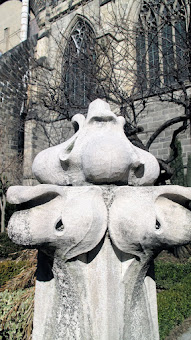Grateful for talented artisans in the interior design industry






What's on Our List Today?

-snippets from the New American Wing at the Metropolitan Musuem of Art to showcase the many talented artisans going back hundreds of years.-A tour of the official residence of the Mayor of New York City, and one of the oldest wooden structures in Manhattan, The Gracie Mansion-dedication to Chris Pellettieri, a talented stone carver harkening back to the days of the "guilds" from the Middle Ages when artisans apprenticed with a mentor program to hone their skill-A cookie craftsman


With all the interior design professionals flooding the industry, there seems an endless supply of options when considering how to decorate a home. Interestingly, these talented individuals have helped form how we view our homes going back hundreds of years. This month let's celebrate the talented craftsmen throughout history by illustrating their contributions, with a special feature of a modern day stone carver. As I look over these past ten months since I created this blog, there is a thread that weaves through each topic I explore - the emphasis on the importance of history in interior design.
I would like to dedicate an entire post to the future of interior design and where we seem to be headed, and maybe that would make a great topic for my one year anniversary of Nest by Tamara, but for February I point out the ways in which the foundations of good design have been laid down long before this generation. From the research I culled this month, I got an idea for March's topic as well; I plan to investigate the process of refurbishing a historic home. The journey of taking something old, often in a state of disarray, and preserving the goodness and richness while upgrading what is no longer viable to make a modern livable space, can be an enriching, albeit daunting experience. In March I will refer to my personal experiences with this process. Last month I wrote about Edith Wharton's visions during the late 1800s, and how her unique voice brought great taste and symmetry to the field. Edith looked back to the past when she wrote her book the Decoration of Houses, and valued the Federal style from the 1700s for its sensibilities and cohesive aesthetics.
For February, I explore the importance of history, not just from the perspective of the visionaries of design as I did with Edith, but from the view of the craftsmen that continue to contribute beautiful, well made goods. Going back to the days of the "guilds" in Europe during the Middle Ages and later in the United States, there was a strong emphasis on learning a trade. The finest guilds were often considered the noblest and most valued men in society as their creations often moved the country or their particular region forward in status. Through apprenticeship programs, these craftmens learned a skill and under a mentor they honed that talent slowly over time, somethimes over a lifetime. This often tranformed an entire family's identity, even forming their surname. These skills were most often passed down through generations. We still value artisans in our society today, but of course with the many changes that have occured in the last few hundred years, our emphasis has shifted a bit.
If you look around your community, you will find a group of skilled artisans hard at work providing quality art and wares for those who desire the work of an articulate hand. Every good interior designer has a list of talented, hard-to-find artisans in their Rolodex, and it becomes an important part of being successful in this business. Many designers covet these often hard to find sources. With the ever growing computer community sites these sources are now becoming more easily accessible, and again the world is changing. Without these individuals, we would only have mass produced items to choose from. We are fortunate to have the option of both less expensive and easily accessible items (thank you IKEA), but can integrate fine unique handmade pieces or antiques into our home thanks to a long history of artisans in our country.
I start with a trip to the MET (Metropolitan Museum of Art), and show some new editions to the New American Wing set in a Federal-Style building. This transformation will be complete in 2011, and takes visitors through a historic journey through American history of the decorative arts. Next, I take a tour of New York City's Gracie Mansion, and the subject steers us back again to the topic of the importance of history and preservation. This home has gone through many iterations and through the efforts of many philanthropists, the craftmanship has been preserved. I dedicate this month's topic to a stone carver named Chris Pellettieri, and he had been fortunate to have learned his craft over years as a member of an apprenticeship at the Cathedral Church of Saint John the Divine. Chris' work is detailed and beautiful, and I hope you find the story about his lifelong passion inspiring.
I hope February's dedication to the artisans from the past, with a special look at a modern day stone carver, helps to deepen your appreciation and respect for these craftsmen.
A TOUR OF GRACIE MANSION friends Lisa and Cheryl standing in front of the entrance plaque at Gracie Mansion on East End AvenueWhat do you know aboutNew York City's gem?Much effort has gone into preserving and enhancing Gracie Mansion,one of the oldest wooden structures in New York City
friends Lisa and Cheryl standing in front of the entrance plaque at Gracie Mansion on East End AvenueWhat do you know aboutNew York City's gem?Much effort has gone into preserving and enhancing Gracie Mansion,one of the oldest wooden structures in New York City

 blue room and library detail of Federal fireplace and tole lanterns below
blue room and library detail of Federal fireplace and tole lanterns belowtypical hallway during Federal period- painted faux surfaces - the wooden floor painted to mimic more expensive marble material
Gracie Mansion is a grand old home and a special landmark for New York City. Like many New Yorkers, I am familiar with its looming facade in Carl Schultz Park overlooking the East River, and its grandness harkens back to the another era in the City. As the official residence of the New York City Mayor, although our current Mayor Michael Bloomberg opts to reside in a townhome on 79th Street, this historic home is valued, preserved and utilized in many ways. It is a grand, pale yellow Federal-style wooden home with a very interesting past, ironically, mirroring the City's ups and downs over hundreds of years. Through its winding path of changing hands, preservation and refubishment, it is now one of the City's brightest gems. I took a tour of the home yesterday and learned a bit more about its history and importance.Shipping merchant Archibald Gracie built the home in 1799. Gracie held many elaborate dinner parties in the home, but after he fell upon financial hard times he sold it in 1823. The home changed hands a couple more times, and eventually was seized by the City. In 1910, the 11-acre property and home were added to the newly-formed Carl Schultz Park. For many years, the house acted as a concession stand in the Park until 1924 when it was restored to become the first home of the Museum of the City of New York. The Museum moved to its current residence on Fifth Avenue, and Gracie Mansion became a historic house in 1936. Robert Moses designated it the official residence of the Mayor, and the Mayor Fiorella H. LaGuardia was the first Mayor to reside in Gracie Mansion in 1942. The house was enlarged in 1966 with the addition of the Susan E. Wagner Wing. The building has an usual three-sided porch, and trellis railings that sweep around the house.
The home is truly a testament to the Federal style of architecture, with its emphasis on symmetry, symbols of hospitality, Duncan Phyfe furniture, convex mirrors, looking glass mirrors, inlaid fireplace (original to the house), and much attention to detail. Two doyens gave us the tour, and I found them to possess impressive knowledge of the history of New York City.

















historic structure and acquire furnishings that
illustrate the rich history of
New York; improve the surrounding landscape
and gardens; and provide educational
services, including publications and tours".
















